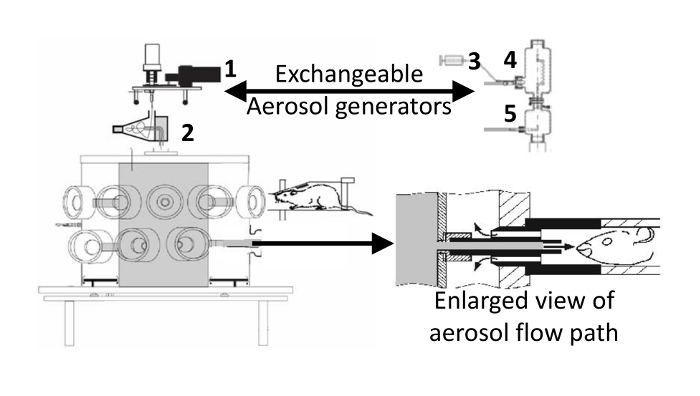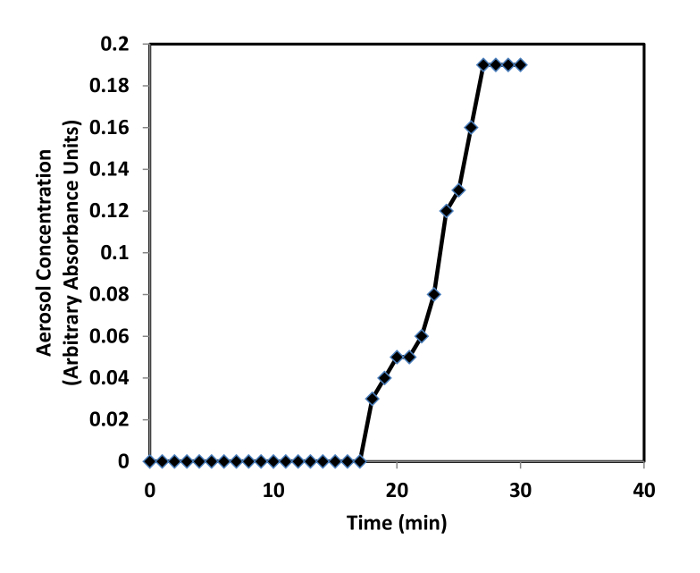A Technique to Generate and Deliver Drug Aerosols Directly to Mouse Lungs
Abstract
Source: Phillips, J. E. et al., Dry Powder and Nebulized Aerosol Inhalation of Pharmaceuticals Delivered to Mice Using a Nose-only Exposure System. J. Vis. Exp. (2017)
This video demonstrates the generation of drug aerosols and the targeted nose-only delivery of these aerosols to mice using an inhalation unit equipped with an aerosol generator. The mouse is restrained in a nose-only restrainer and connected to the inhalation unit, which delivers the drug directly into the mouse's nasal cavity. Subsequently, the drug passes through the trachea and enters the lungs.
Protocol
All procedures involving animal models have been reviewed by the local institutional animal care committee and the JoVE veterinary review board.
1. Formulation and Device Selection for the Generation of Pharmaceutical Aerosols
NOTE: Formulation and device selection depend on the individual drug's physicochemical properties to be aerosolized.
- Nebulized liquid aerosols.
- Dissolve the drug in 100 mL of water or physiologic saline.
- Load a 100 mL syringe with the drug solution and place the syringe into the syringe pump with a flow rate set at 1 mL/min.
- Connect the syringe pump to the jet nebulizer and purge the air from the feed line leading to the nebulizer.
- Connect the pressurized air source to the jet nebulizer and set the airflow meter to 10 L/min.
- Insert the jet nebulizer into the pre-separator. The pre-separator connects the nebulizer to the central aerosol plenum of the inhalation unit (Figure 1).
NOTE: Many drug compounds have limited aqueous solubility and are better formulated as dry powder aerosols. If a stable suspension can be made from a micronized mass median aerodynamic diameter (MMAD < 5 μM) compound, it may be used with the jet nebulizer. Caution should be used as the suspension may clog the nebulizer. Nebulizer feed concentrations from 1 mg/mL for potent compounds (like the bronchodilator ipratropium) to 40 mg/mL suspensions (for less potent compounds like salbutamol sulfate) have been used. The syringe pump feed rate is set at 1 mL/min for a practical reason: to allow the aerosol concentration equilibration period and 45-min-long exposure to be completed without the need to reload the syringe.
2. Aerosol Exposure Experiment Setup
- Measure the drug concentration (by collecting aerosol on an absolute filter) and particle size distribution (by collecting aerosol using a cascade impactor) of the aerosol that enters the inhalation unit post pre-separator/cyclone. Use these parameters, the animal's minute ventilation, body weight, and exposure time, to estimate the drug dose deposited in the lungs.
- Weigh the absolute filter and record the filter weight. Place the filter into the filter holder and assemble the filter holder. Connect the inlet of the absolute filter holder to a central aerosol plenum sample port and the outlet to a vacuum source set to sample the aerosol at a flow rate of 1 L/min for the experiment.
NOTE: The mass of the drug on the filter after sampling for 45 min can be in the sub-microgram range and/or be mixed with lactose, NaCl salt, or another vehicle. A microbalance that reads to 0.1 micrograms is necessary. The filter must be equilibrated and weighed in a humidity-controlled environment to get an accurate weight of the drug deposited on the filter. The weight of the drug on the filters can only be used in dose calculation if there is no vehicle in the formulation or the vehicle is water. When there is a vehicle in the formulation other than water, the weight of the substance on the filter only gives an estimated starting point for further drug content analysis by high-performance liquid chromatography (HPLC). - Weigh and record the weight of the 7 cascade impactor stage filters and one final "tailpiece" filter. Place a filter on each of the seven stages of the cascade impactor and assemble the Mercer cascade impactor. Connect the inlet of the cascade impactor to a central aerosol plenum sample port and the outlet to a vacuum source set to sample the aerosol at the flow rate the cascade impactor is calibrated at (usually 0.5 or 1 L/min) for the duration of the experiment.
- Monitor the aerosol content of the inhalation unit with the real-time aerosol monitor (see Table of Materials and Reagents) to confirm the aerosol generators are functional and producing a stable aerosol throughout the experiment. Connect the inlet of the real-time aerosol monitor to a central aerosol plenum sample port and the outlet to a vacuum source set to sample the aerosol at a flow rate of 1 L/min for the experiment.
NOTE: The real-time aerosol monitor signal is reported in μg/L but is calibrated for road dust and must be recalibrated for each drug aerosol to yield correct aerosol concentration values. Calibration is unnecessary when using the monitor to confirm aerosol concentration's presence or absence and temporal stability. - Set the process control parameters (airflow, vacuum, pressure, aerosol generator power) to the required values that depend on the number of animals connected to the inhalation unit. The inhalation unit and aerosol generators are continuously controlled/monitored by a computerized process control/data acquisition system (DACO) supplied by the manufacturer (see Table of Materials and Reagents). The airflow rate into the inhalation unit should be minimally approximately 2 times the total minute ventilation rate of all animals in the inhalation unit to avoid a buildup of CO2.
- Weigh the absolute filter and record the filter weight. Place the filter into the filter holder and assemble the filter holder. Connect the inlet of the absolute filter holder to a central aerosol plenum sample port and the outlet to a vacuum source set to sample the aerosol at a flow rate of 1 L/min for the experiment.
- Load mice into nose-only restrainers before exposing them to aerosol in the nose-only inhalation unit. Also load restraint stress control animals into restrainers to breathe room air.
NOTE: A dose/response experiment consists of multiple groups of mice exposed to aerosol for different amounts of time. Exposure time controls each group's dose during a dose/response experiment.- Angle the restraining tube towards the ceiling while trying to load the animals, as they tend to run upward, trying to escape. Pointing the tubes down while loading will encourage turning around and escaping out the back of the tube. Ensure the mouse's nose is oriented into the pointed end of the tube and fix the variable-position plunger into the back end of the restrainer.
NOTE: The plunger is fashioned to allow the mouse's tail to protrude from the holder, which enables the mouse to regulate its body temperature while in the restrainer. - Adjust the plunger to allow the mice to rotate but not turn head to tail to ensure the aerosol is inhaled.
- Continuously monitor the mice while in the restraining tubes. After positioning the plunger, small mice (<20 grams) often attempt to turn head to tail in the tubes and adopt a U-position where they have trouble breathing. This turning behavior is most prevalent in the first 5 minutes of restraint; after that, the mice rarely attempt to turn head to tail.
- Angle the restraining tube towards the ceiling while trying to load the animals, as they tend to run upward, trying to escape. Pointing the tubes down while loading will encourage turning around and escaping out the back of the tube. Ensure the mouse's nose is oriented into the pointed end of the tube and fix the variable-position plunger into the back end of the restrainer.
3. Aerosol Delivery
- Insert stoppers to plug the delivery ports of the inhalation unit and activate the aerosol generator, compressed air flow controller, and inhalation unit vacuum pump from within the process control software.
- Once the readings from the real-time aerosol monitor demonstrate the aerosol concentration has to come to equilibrium (~30 min, Figure 2), begin removing stoppers and inserting the nose-only restraining tubes containing mice into the inhalation unit. Repeat until all mice exposed to the drug are connected to the inhalation unit.
NOTE: In the example experiment, the total airflow supplied to the inhalation unit via the aerosol generator and dilution air is set to provide a 0.5 L/min flow rate to each animal exposure port in use. For example, a 15 L/min total airflow is enough to supply each of the 30 ports in the inhalation unit. This is much more airflow than required by the minute ventilation of the mice, but a larger airflow is necessary to supply the energy (pressure drop across the aerosol generator) to produce (atomize/de-agglomerate) the aerosol. - Once all animals are loaded into the exposure unit, turn on the vacuum sampling pumps connected to the absolute filter and cascade impactor using the process control software.
- When all exposures are completed, turn off the aerosol generator and remove the remaining mice from the inhalation unit.
NOTE: Animals will be handled in a change station hood or by personnel wearing a facemask. After the conclusion of aerosol delivery, the mice are removed from the tubes and sanitized after each use.
Representative Results

Figure 1: Inhalation unit with dry powder aerosol generator attached. The nebulizer used to generate aerosol from liquid formulations is shown on the right. 1) Wright dust feed, 2) cyclone, 3) syringe pump, 4) jet nebulizer inserted into pre-separator, 5) dilution air mixer. When delivering nebulized aerosols, the dust feed, and cyclone are replaced by the syringe pump, jet nebulizer/pre-separator, and dilution air mixer. The enlarged view shows the aerosol flow path at the breathing zone around the animal's nose, created by inserting the restraining tube into the inhalation unit. The aerosol fills the central aerosol (grey) plenum of the inhalation unit and flows out to the animal's nose, where it is pulled back by a slight vacuum in the outer (white) plenum and into the waste collection filters (not shown).

Figure 2: Real-time aerosol monitor measurements confirm the aerosol concentration in the inhalation unit reaches equilibrium ~30 min after turning on the aerosol generator.
Declarações
The authors have nothing to disclose.
Materials
| Nose-only exposure inhalation unit | TSE systems | 700100-KNES-040-ss | Custom configurations available |
| DACO data acquisition system | TSE systems | 700400-PRO-C-D/1 | |
| MC One Jet Mill | Jetpharma | DEC MicroJet 10 | |
| Turbula Mixer | GlenMills Inc | T2F | |
| Micronized Lactose | DFE Pharma | Lactohale 200 | |
| Hydraulic press | Specac | GS15011 | |
| Cascade impactor filters | Pall Life Sciences | 7219 | Emfab filter |
| Absolute filters | Whatman | 10370302 | 5 cm diameter |
| Real time aerosol monitor Microdust Pro Monitor |
Casella | CEL-712 | |
| Ipratropium bromide | Spectrum Chemical | I1178 | pre-micronized |
| flexiVent FX1 system | scireq | FV-FXCS |
Tags

.
